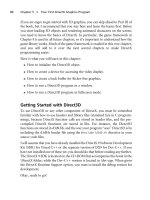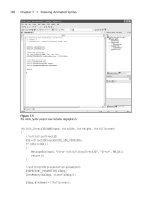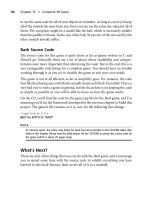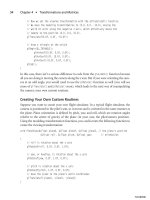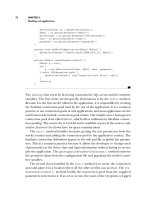Black Art of Java Game Programming PHẦN 4 ppsx
Bạn đang xem bản rút gọn của tài liệu. Xem và tải ngay bản đầy đủ của tài liệu tại đây (6.17 MB, 98 trang )
Black Art of Java Game Programming:Creating Customizable Games with the AWT
Selected methods in the abstract class Container are listed in Table 7-12.
Table 7-12Container methods
Container Methods Purpose
public Component add(Component c); Adds the specified component
public Component add(String s,Component c); Adds component with String argument
public Insets insets(); Creates insets
public void setLayout(LayoutManager m); Uses the specified layout manager
public synchronized void remove(Component c); Removes the specified component
public synchronized void removeAll(); Removes all components from
container
Components
Table 7-13 lists the components we’ve discussed in this chapter and selected methods that are
available. Remember that these classes also inherit the Component methods listed above.
Table 7-13Components
Class Methods
Button public Button();
public Button(String label);
public String getLabel();
public void setLabel(String label);
Checkbox public Checkbox();
public Checkbox(String label);
public Checkbox(String label,
CheckboxGroup group,boolean state);
public String getLabel();
public boolean getState();
public void setLabel(String label);
public void setState(booleanstate);
file:///D|/Downloads/Books/Computer/Java/Blac 20Java%20Game%20Programming/ch07/264-267.html (2 von 4) [13.03.2002 13:18:24]
Black Art of Java Game Programming:Creating Customizable Games with the AWT
CheckboxGroup public CheckboxGroup();
public Checkbox getCurrent();
public synchronized void
setCurrent(Checkbox box);
Label public Label();
public Label(String label);
public Label(String label,int alignment);
public int getAlignment();
public String getText();
public void setAlignment(intalignment);
public void setText(String label);
TextField public Textfield();
public Textfield(int size);
public Textfield(String text,intsize);
public String getText(); //
inherited from TextComponent
public setText(String text); //
inherited from TextComponent
Containers
Table 7-14 lists the containers discussed in this chapter and selected methods that are available.
Table 7-14Container classes
Container Methods
Dialog public Dialog(Frame parent,boolean modal);
public Dialog(Frame parent,String title,boolean modal);
public synchronized void dispose(); //
inherited from Window
public boolean isModal();
public boolean isResizable();
public synchronized void pack(); //
inherited from Window
public void setResizable(boolean b);
Frame public Frame();
file:///D|/Downloads/Books/Computer/Java/Blac 20Java%20Game%20Programming/ch07/264-267.html (3 von 4) [13.03.2002 13:18:24]
Black Art of Java Game Programming:Creating Customizable Games with the AWT
public Frame(String title);
public synchronized void dispose(); //
overrides dispose() from Window
public MenuBar getMenuBar();
public boolean isResizable();
public synchronized void pack(); //
inherited from Window
public void setCursor(int cursorType);
public synchronized void
setMenuBar(MenuBar mb);
public void setResizable(boolean b);
Panel public Panel();
Cursors
Cursor types are static constants defined within the Frame class. To set the cursor, use the Frame
method
public void setCursor(int cursorType);
Previous Table of Contents Next
file:///D|/Downloads/Books/Computer/Java/Blac 20Java%20Game%20Programming/ch07/264-267.html (4 von 4) [13.03.2002 13:18:24]
Black Art of Java Game Programming:Creating Customizable Games with the AWT
Black Art of Java Game Programming
by Joel Fan
Sams, Macmillan Computer Publishing
ISBN: 1571690433 Pub Date: 11/01/96
Previous Table of Contents Next
Table 7-15 lists the cursors that are available.
Table 7-15Cursor types
Cursor Appearance
Frame.CROSSHAIR_CURSOR
Frame.DEFAULT_CURSOR
Frame.E_RESIZE_CURSOR
Frame.HAND_CURSOR
Frame.MOVE_CURSOR
Frame.NE_RESIZE_CURSOR
Frame.NW_RESIZE_CURSOR
Frame.N_RESIZE_CURSOR
Frame.SE_RESIZE_CURSOR
Frame.SW_RESIZE_CURSOR
Frame.S_RESIZE_CURSOR
Frame.TEXT_CURSOR
file:///D|/Downloads/Books/Computer/Java/Blac 20Java%20Game%20Programming/ch07/267-272.html (1 von 4) [13.03.2002 13:18:25]
Black Art of Java Game Programming:Creating Customizable Games with the AWT
Frame.WAIT_CURSOR
Frame.W_RESIZE_CURSOR
Menu, MenuBar, and MenuItem
Table 7-16 lists selected methods for Menu, MenuBar, and MenuItem.
Table 7-16Menu, MenuBar, and MenuComponent
Class Methods
Menu public Menu(String label);
public synchronized MenuItemadd(MenuItem mi);
public synchronized void
remove(MenuComponent item);
MenuBar public MenuBar();
public synchronized Menu add(Menu m);
public synchronized void
remove(MenuComponent item);
MenuItem public MenuItem(String label);
public void disable();
public void enable();
public void enable(boolean cond);
The Event Class
Table 7-17 lists instance variables of the Event class.
Table 7-17Instance variables of the Event class
Event Instance Variables Purpose
public Object arg; Argument that depends on event type
file:///D|/Downloads/Books/Computer/Java/Blac 20Java%20Game%20Programming/ch07/267-272.html (2 von 4) [13.03.2002 13:18:25]
Black Art of Java Game Programming:Creating Customizable Games with the AWT
public int clickCount; The number of consecutive mouse clicks
(e.g., clickCount = 2 for a double-click)
public Event evt; The next event (used to create a linked list of
events)
public int id; The type of event
public int key; The key (used for key events)
public int modifiers; Modifier keys used during event
public Object target; The object that triggered the event
public long when; Time that event occurred
public int x,y; x and y coordinates of event
The id variable tells you the type of the event. Table 7-18 shows the values that id can take on. These
values are defined as static constants in the Event class.
Table 7-18Event types
Event.id Value Interpretation
ACTION_EVENT Action event
GOT_FOCUS, LOST_FOCUS Component got/lost input focus
KEY_ACTION, KEY_ACTION_RELEASE,
KEY_PRESS, KEY_RELEASE Key event
LIST_SELECT, LIST_DESELECT List event
LOAD_FILE, SAVE_FILE File event
MOUSE_DOWN, MOUSE_UP, MOUSE_DRAG
MOUSE_MOVE, MOUSE_ENTER, MOUSE_EXIT Mouse event
SCROLL_ABSOLUTE,
SCROLL_LINE_UP, SCROLL_LINE_DOWN
SCROLL_PAGE_UP, SCROLL_PAGE_DOWN Scrollbar event
WINDOW_DESTROY, WINDOW_EXPOSE,
WINDOW_DEICONIFY, WINDOW_ICONIFY
WINDOW_MOVED Window event
The interpretation of the Object argument to the action() method depends on the type of component
that triggered the event. Table 7-19 associates the component (stored in the target variable) with the
Object argument.
file:///D|/Downloads/Books/Computer/Java/Blac 20Java%20Game%20Programming/ch07/267-272.html (3 von 4) [13.03.2002 13:18:25]
Black Art of Java Game Programming:Creating Customizable Games with the AWT
Table 7-19Interpreting arguments to action(Event evt, Object obj)
If evt.target Is an Instance of Then obj Is an Instance of
Button String (the button label)
Checkbox boolean (the checkbox state)
Choice String (the chosen item)
MenuItem String (the chosen item)
TextField String (the input text)
Suggestion Box
• Allow the player to customize other features of the game, such as the bitmaps for the missile
launcher, the aliens, or the explosions. Other possibilities for customization are the speed of the
missiles, the scoring, and the color (or bitmap) for the background.
• Explore the other widgets in the AWT. Here are the ones we didn’t cover in this chapter:
Choice, List, Scrollbar, and TextArea. These aren’t hard to learn, and the pattern of creating
interfaces remains the same.
• Learn how to use GridBagLayout. This LayoutManager is the most powerful that the AWT
provides, and you will use it in Java projects to come!
Summary
In this chapter, you’ve seen how Java’s AWT allows players to interact with and customize your
games in an easy, intuitive fashion. By allowing customization, your games can appeal to the broadest
audience possible. And by using the AWT, your applications and games can have graphical front ends
that are portable to any platform that runs Java.
In the next chapter, you’ll see how to use networking in your games!
Previous Table of Contents Next
file:///D|/Downloads/Books/Computer/Java/Blac 20Java%20Game%20Programming/ch07/267-272.html (4 von 4) [13.03.2002 13:18:25]
Black Art of Java Game Programming:Implementing a High Score Server on a Network
Black Art of Java Game Programming
by Joel Fan
Sams, Macmillan Computer Publishing
ISBN: 1571690433 Pub Date: 11/01/96
Previous Table of Contents Next
Part II
Advanced Game and Graphics Techniques
Chapter 8
Implementing a High Score Server on a Network
Eric Ries
Goals:
Understand client-server networking fundamentals
Implement high scores in Java
Use Threads, Sockets, and Files
Build a server
Allowing competition among players enhances the enjoyment of any game. In traditional
programming environments, a “high score list” is used to allow players to keep track of their best
scores, thus providing an incentive for further play. Java extends this paradigm to a new level. By
allowing communications over the Internet, Java allows players to compete against other players
worldwide.
Implementing a high score server in Java is relatively simple when compared with older-generation
languages. To do this, you need two separate components: the client and the server. The client is the
program (your game, in this case) that runs on the user’s computer. The server is the program that
runs on the machine where your programs were initially located. By obtaining information from, and
reporting back to, the server, your Java game can display and continually update a list of the best
players of your game. This can be a decisive advantage for your game over other games that compete
for users’ attention.
file:///D|/Downloads/Books/Computer/Java/Blac 20Java%20Game%20Programming/ch08/273-281.html (1 von 4) [13.03.2002 13:18:26]
Black Art of Java Game Programming:Implementing a High Score Server on a Network
In this chapter, there are two things we need to discuss. The first is using Java to handle high scores
using concepts this book has already discussed. The second part of the chapter discusses using Java to
implement these concepts over a network.
Why Use Java for Network Programming?
Client-server communication over the Internet has obviously been around much longer than Java.
Java, however, brings with it an unprecedented level of ease-of-use in network programming. Being
game programmers, we have absolutely no need to waste our time with all of the details of Internet
communications (and there are many details). Java allows us to focus on the more important aspects
of the program while it transparently takes care of the messy stuff in the background.
What Is Client-Server Networking?
Most individuals with a reasonable amount of computer experience understand the basics of client-
server networking. However, generations of computer science majors have managed to come up with
an entire lexicon designed to confuse you. Things like sockets, ports, packets, and streams may sound
like they have more to do with fishing than with computers, so let’s start with a metaphor to help us
along.
Basic Client-Server Terminology
Pretend you are trying to reach customer support at a huge corporation (a painful experience all of us
have had). You call the company and reach the receptionist, who asks you for an extension. Luckily,
you have the number handy, and you are transferred to the customer representative. The two of you
have a delightful conversation, and then you both hang up. The whole process is simple and
straightforward; any child could tell you how it’s done. Unfortunately, to do something simple like
this on a network requires a whole new vocabulary. Let’s start with the most common terms we need
to know:
• Client. The entity making the call (in our example, you).
• Server. The entity processing your requests (the company, in our example).
• Socket. Computers on the Internet communicate just like you did with your customer service
representative. However, instead of telephones, computers use sockets. Java provides you with
a very handy Socket class, which handles all of the low-level code for network
communications. All you have to do is dial.
• IP address. For one computer to call another computer, it needs a “phone number.” In
Internet language this is called an IP (for Internet protocol) address. This is a series of numbers
and periods that looks something like this: 131.247.1.58. While this may not be too meaningful
to a human being, an Internet computer can use it just like a phone number.
• Domain name server (DNS). What if you didn’t know the number of a company? For a
computer, this is never a problem, because computer memory is flawless. Humans are not so
well equipped, so we sometimes rely on a phone book to find the number we’re looking for.
On the Internet, this is called a domain name server (DNS), and it is what allows you to type in
file:///D|/Downloads/Books/Computer/Java/Blac 20Java%20Game%20Programming/ch08/273-281.html (2 von 4) [13.03.2002 13:18:26]
Black Art of Java Game Programming:Implementing a High Score Server on a Network
an address like “www.waite.com” instead of all those pesky numbers. Using an IP address or
its DNS equivalent, a client program can open a socket connection to a server. Bear in mind
that every computer connected to the Internet must have a unique IP address assigned to it.
• Port. What does a client do once it has connected to a server? Just as in our example, it gets
the receptionist, who asks it for an extension. In Internet jargon, the extension is called the
port. On any one machine, any program can access any port, which is usually given a number
between 1 and 9999.
• Service. No two programs can share a port, so each port represents a different service offered
by the server. In order for a client and a server to communicate, the server must be listening to
the same port that the client is calling on. Otherwise, your client might get sales instead of
customer support.
• Protocol. Now, when you finally get through to someone on their extension, it doesn’t do
anybody any good if they speak Korean and you speak Portuguese. In order to do any kind of
useful communicating, the client and the server must use the same protocol. A protocol is like
a language that computers use to speak to each other. A protocol defines the order and type of
interactions that can take place in a socket connection. Even though you may not know it, you
are probably familiar with many protocols already.
• HyperText Transfer Protocol (HTTP). This is the most popular protocol on the World Wide
Web. It is used to send a wide variety of textual and multimedia data. Other common ones
include Gopher, Telnet, FTP , WAIS, and SMNP. The protocols that we will be using are far
less complex, but the concepts are the same.
A typical phone conversation is shown in Figure 8-1, and its networking equivalent is shown in Figure
8-2.
Figure 8-1 Diagram of telephone conversation
Figure 8-2 Networking equivalents of telephone metaphor
file:///D|/Downloads/Books/Computer/Java/Blac 20Java%20Game%20Programming/ch08/273-281.html (3 von 4) [13.03.2002 13:18:26]
Black Art of Java Game Programming:Implementing a High Score Server on a Network
Previous Table of Contents Next
file:///D|/Downloads/Books/Computer/Java/Blac 20Java%20Game%20Programming/ch08/273-281.html (4 von 4) [13.03.2002 13:18:26]
Black Art of Java Game Programming:Implementing a High Score Server on a Network
Black Art of Java Game Programming
by Joel Fan
Sams, Macmillan Computer Publishing
ISBN: 1571690433 Pub Date: 11/01/96
Previous Table of Contents Next
Some Additional Concepts
Before we begin to write the client and server code, there are a few concepts that must be understood. These
are not necessarily concepts that are unique to networking, but are used in many higher-level languages. In
fact, they might already sound familiar. In Java, they are especially important.
Exception Handling
In Java, whenever an error occurs, an exception is thrown. This exception must be caught and handled by
whatever class invoked the method that caused the error. Exception handling is very useful, because usually
your program is going to want to know if something went wrong, and, more importantly, exactly what went
wrong.
When a problem arises in Java, your program will be sent an Exception object that describes what kind of
error took place. What kinds of things can generate exceptions? Well, let’s return to our now-overused
metaphor for client-server networking, since this is where exceptions are most likely to occur. Let’s say you
tried to call your “server” company, and instead you got the operator saying “this number has been
disconnected.” Or what if you got Joe’s Bait and Tackle Store instead? Or what if the phone was busy, or the
receptionist couldn’t find your extension, or the person you reached spoke Latin? All of these things would
throw an exception, and you would be expected to do something with it. Now, in most of the code we will
write in this chapter, we won’t care what went wrong. Whether the phone rang through or was busy, we will
just abort and try again later.
Streams
In Java, as in many other programming languages, when we want to get data from the outside world, we have
to use a stream. Streams are classes that allow for data input and output, but they only work in one direction.
There are also many kinds of streams, but all of them are subclasses of the InputStream and OutputStream
classes. Some examples of these subclasses are DataInputStream, FileOutputStream, and PrintStream. In fact,
you are probably already familiar with PrintStream, because it is used whenever you access System. Streams
are very important, and you will see them crop up many times in this chapter.
Implementing Our Client Server Game Model
How does all of this client-server information relate to our high score server? You probably have realized by
now that, in the client-server model, our game applet running on the user’s machine will be the client and that
another program running on the host machine will be the server. The client will have to open a socket to the
server, request the high score data, and process it. Let’s take a look at what the client and the server are going
file:///D|/Downloads/Books/Computer/Java/Blac 20Java%20Game%20Programming/ch08/282-284.html (1 von 3) [13.03.2002 13:18:27]
Black Art of Java Game Programming:Implementing a High Score Server on a Network
to have to do.
Implementing Client Features
Because Java is an object-oriented language, we can create a high score client “module” that can be plugged
into any game you write. Because we do not want to bog down the server machine with many calculations,
the client applet will be doing most of the work, and it is necessarily the most complex part of this chapter.
The client must perform the following functions:
• Request, parse, and sort data. The client must request data from the server, parse it (break it up into
usable portions), and then sort it. The data will initially consist of high score names and scores that
must be stored together in descending order. Later we will add more types of data.
• Report the data. The client must be able to report back to the server a potential high
score—however, we do not want the server to be bogged down with superfluous requests, so the client
must be able to reject known low scores.
• Display the data. The client must display the high scores in a snazzy and flexible manner, so that
they can be incorporated into any existing game structure.
• Operate independently of the server. The client must be able to perform all of its necessary functions
in the absence of a network server. This is important, not only for testing, but also if, for some reason,
the high score server is unavailable (or the user does not wish to compare his/her scores with other
players).
• Check for new data. The client must periodically check the server for new data, and, if necessary,
request it.
Creating the HighScoreManager Class
To implement these features, we will first create a new Java class, called HighScoreManager, which will
perform the bulk of the work required. The HighScoreManager class will also include a special class called
HSob, which will be used for storing the high score data in discrete units. Each HSob will have the following
properties:
name // a string used to store a player's name
score // a "float" used to store the player's score
The HighScoreManager will make use of the following methods and variables:
NUM_SCORES // The number of high score objects in our array
scores[] // The actual array of scores, stored in descending⇐
order
getScoreData() // Obtains the raw high score data from the server
getScores() // Parses the raw data into an array of High Score Objects
paintScores() // Draws the actual high score list with a spiffy⇐
background
addScore() // Adds a new "HSob" to our array in the proper order
How HighScoreManager Reduces Calculations
file:///D|/Downloads/Books/Computer/Java/Blac 20Java%20Game%20Programming/ch08/282-284.html (2 von 3) [13.03.2002 13:18:27]
Black Art of Java Game Programming:Implementing a High Score Server on a Network
There are several things that are important to notice at this point. First of all, there is no sorting method.
Because we store the scores in descending order in our scores [] array, it may seem that some kind of sorting
mechanism is required. However, such sorting routines (most commonly, a “bubble sort”), are resource-
consuming and altogether inefficient. To avoid using a sorting routine, we make sure to add scores in the
proper place in the list every time. Another important aspect of our design is that it requires almost no
calculation to be done by the server. The server merely needs to send us a string of raw data that we can parse,
and process our occasional updates (more on this later).
Previous Table of Contents Next
file:///D|/Downloads/Books/Computer/Java/Blac 20Java%20Game%20Programming/ch08/282-284.html (3 von 3) [13.03.2002 13:18:27]
Black Art of Java Game Programming:Implementing a High Score Server on a Network
Black Art of Java Game Programming
by Joel Fan
Sams, Macmillan Computer Publishing
ISBN: 1571690433 Pub Date: 11/01/96
Previous Table of Contents Next
Implementing Server Features
Now that we understand the way the client will work, we must be sure that we have an effective model for
our server, so we can certify that the two will work together nicely. Our server model should be one that
compliments the strengths of the client.
Effect of Client Design on Server Performance
The advantage of our client design above is that it requires very little processing by the server. This is ideal
for a networking environment for two reasons.
• First, the server could be handling potentially thousands of requests, and if it had to perform
calculations on each one, it would quickly become bogged down. By distributing the computational
load among all of the client computers, we decrease the burden on the server considerably.
• Second, the server itself need not be implemented in Java. Several methods of doing simple server
requests are available, most commonly the Common Gateway Interface (CGI), which allows for
server programs to be written in many languages. We will explore different methods of implementing
our server later.
Tasks Performed by the Server
No matter what language our server is written in, it still must perform the following tasks:
• Provide a string of data representing all high scores upon request. This list may be in numerical
order, but not necessarily so (remember that our client will parse and order the data later).
• Receive score and name information from clients and, if applicable, add them to the high score list.
• Keep track of the last time a change was made to the list of high scores, so that the client can check
if it needs to request the data again.
Creating the High Score Objects
The first step in creating both the client and the server is to create a series of object classes that can be used
to effectively store, retrieve, and transmit high scores. For this, we will create a special class for a single
high score, and a class for a list of many high scores.
The HighScoreList Class
file:///D|/Downloads/Books/Computer/Java/Blac 20Java%20Game%20Programming/ch08/284-287.html (1 von 4) [13.03.2002 13:18:27]
Black Art of Java Game Programming:Implementing a High Score Server on a Network
The first class we need to write is one that will be used by both the server and the client. This class keeps
track of a bunch of high scores and keeps them in order. Let’s start with the most basic skeleton of the
HighScoreList class, which we can put in a file called HighScoreList.java:
import java.util.*; // We will need these Java classes
import java.lang.*;
public class HighScoreList extends Object {
int NUM_SCORES = 10; // Number of scores - default value is ten
public long lastChange = 0; //Last time a change was made to the list
HighScoreList() {
}
}
Scoring Variables
We have started with two important variables in HighScoreList. NUM_SCORES, as the name implies, will
keep track of the number of scores in our list. The other number is a “long” integer (which means it can get
really really really big) called lastChange. Even though Java provides a very extensive Date class that can
be used to display dates and times, we don’t need all of that functionality. Instead, we are only going to keep
track of the number of milliseconds since the beginning of the current epoch. This is a huge number, and
you probably would not want to have to memorize it, but computers lovebig numbers. Tracking this number
gives us a convenient way to see if we need to ask for new data from the server. More on this later.
The HSob Object Class
Before we can have a list of high scores, we are going to need our high score object class, HSob, which is
part of the HighScoreList class. Let’s add the code for that.
class HSob extends Object { // High Score Object class
public String name; // Player's name
public float score; // Player's score
/* Remember that we can always add more information about the player⇐
later */
HSob(String n, float sc) { //Initialization routines
name=n;
score=sc;
}
HSob() {
name="noname";
score=0;
}
}
file:///D|/Downloads/Books/Computer/Java/Blac 20Java%20Game%20Programming/ch08/284-287.html (2 von 4) [13.03.2002 13:18:28]
Black Art of Java Game Programming:Implementing a High Score Server on a Network
You may have noticed that this class has two different initialization routines. The first is used to construct a
new object, based on data passed in the new() method. The second is used in case we want to create an
object and then add the data later. Next, we should add the HighScoreList itself, which will be an array of
HSob. Declare it like this:
HSob scores[];
Now let’s write the initialization routines for the HighScoreList. We are going to provide two different ones,
just as we did with HSob. The first will allow us to initialize a HighScoreList that will track a certain
number of high scores. It looks like this:
HighScoreList(int num) {
NUM_SCORES = num;
scores = new HSob[NUM_SCORES];
}
The other routine will allow us to create a new HighScoreList that starts out with a certain number of high
scores already in it. However, before we can create this routine, we are going to need a new method for
parsing data.
Data Parsing
When we get data from the server, it is going to be one long string of values. The art of “parsing” means
taking a string of raw data and turning it into something useful (in this case, an array of high scores). Here is
what a typical raw data string might look like:
"Joe&1000|Bob&250|Gary&52.3|Mary&23|Gabe&5|null|null"
This is a string of seven scores. You may have noticed that they are in the form
“Name1&score1|Name2&score2|….” We have rather arbitrarily chosen relatively uncommon sets of
characters as delimiters to separate meaningful data. Each name/score pair is separated by “|”, and every
name and score is separated by “&”. Also, “null” is used to represent empty slots in the list.
The StringTokenizer Class
To break up a string of data into discrete tokens, we use a class already built into Java, called a
StringTokenizer. The StringTokenizer class is used to break up a string into smaller substrings (called
“tokens”), based on a common separator (now you see why I chose to break up our data with “|”). Here is a
summary of the useful methods in the StringTokenizer class:
new StringTokenizer(String str, String delim)
/* Creates a new StringTokenizer object based on the String str and the⇐
"delimeter" (or separater) delim*/
hasMoreTokens()
/* Returns true if the Tokenizer has more "tokens" left (each substring⇐
is called a "token") */
file:///D|/Downloads/Books/Computer/Java/Blac 20Java%20Game%20Programming/ch08/284-287.html (3 von 4) [13.03.2002 13:18:28]
Black Art of Java Game Programming:Implementing a High Score Server on a Network
nextToken()
/* Returns the next substring token */
countTokens()
/* Returns the total number of tokens in the tokenizer */
Previous Table of Contents Next
file:///D|/Downloads/Books/Computer/Java/Blac 20Java%20Game%20Programming/ch08/284-287.html (4 von 4) [13.03.2002 13:18:28]
Black Art of Java Game Programming:Implementing a High Score Server on a Network
Black Art of Java Game Programming
by Joel Fan
Sams, Macmillan Computer Publishing
ISBN: 1571690433 Pub Date: 11/01/96
Previous Table of Contents Next
Converting Data to Objects
To successfully parse this string of data, we must take each name/score pair from the list and convert it to an
HSob object. We could have just one method do all of this work, but, because we are going to want to be
able to convert back and forth between raw data and objects, we are going to teach the HSob class how to
handle raw data.
Add a third initialization routine to HSob:
HSob(String data) {
Float fl = null;
String str;
StringTokenizer st = new StringTokenizer(data, "&");
while (st.hasMoreTokens()) {
str = st.nextToken();
if (name == null)
name = str;
else
try {
fl = Float.valueOf( str );
score = fl.floatValue();
} catch (Exception e) {
other = str;
}
}
}
This method has some new things in it that you probably noticed. The first is an extra variable called other.
This is a String that we are going to use to hold any additional information included besides the name and the
score (be sure to declare this variable on the same line where you added the name).
Another new concept is the Float class. In Java, for every primitive data type (like int or float), there is a
corresponding object class (like Integer or Float) that has some nifty utility methods useful for that data type.
You may not know it, but you have already used one such class extensively: the String class.
A String object is just a special class for representing an array of characters. For now, we are going to use the
Float class to transform a string representation of a float (like “1000”) into a Float object. You may have
realized that this is exactly what we are teaching our HSob class to do! Once we have the Float object, we
file:///D|/Downloads/Books/Computer/Java/Blac 20Java%20Game%20Programming/ch08/287-290.html (1 von 4) [13.03.2002 13:18:28]
Black Art of Java Game Programming:Implementing a High Score Server on a Network
are then going to extract the actual float number from it, because we really don’t care about the object, only
its cargo. This is also the first time you have seen an Exception being caught—don’t fret, though, it won’t be
the last.
Before we leave the HSob class for a while, we should add another method that is going to be useful down
the line a little bit. This method will take the HSob’s current values and convert them into a raw data string.
public String toDataString() { //Convert an HSob into a data string
return name + "&" + score + "&" + other;
}
The parseData() Method
It’s time to write the data parsing method for the HighScoreList class. Because of all the work we just did
with HSob, this is going to be really easy! We are going to have to use our friend the StringTokenizer class,
so I hope you haven’t forgotten it yet:
public void parseData(String str) { // Parse a string of data
StringTokenizer st1=new StringTokenizer(str,"|");
String theStr;
while (st1.hasMoreTokens() ) {
theStr = st1.nextToken();
if (! theStr.startsWith("null"))
addScore( new HSob (theStr));
}
}
This bit of code references a method we haven’t yet discussed, so we’d better do that now.
The addScore() Method
This is a very important method, so be sure you understand how it works. Its task is to take an HSob and
insert it (if applicable) into the list of scores in its proper place in the sequence. Since the list should already
be in descending numerical order, all we have to do is search down the list until we find either (1) a lower
score or (2) an empty slot. If we find either of these, we add our new score and drop all of the lower scores
down one place. Here is the code:
public int addScore(HSob sc) { // We return the place this score gets
int x,i;
x=0;
if (sc==null) return 0;
while (x<NUM_SCORES) {
if (scores[x] == null || sc.score > scores[x].score) {
for( i=NUM_SCORES-2 ; i>=x ; i )
scores[i+1]=scores[i];
file:///D|/Downloads/Books/Computer/Java/Blac 20Java%20Game%20Programming/ch08/287-290.html (2 von 4) [13.03.2002 13:18:28]
Black Art of Java Game Programming:Implementing a High Score Server on a Network
scores[x]= sc;
lastChange = System.currentTimeMillis();
return x+1;
}
x++;
}
return 0;
}
So long as we never make any changes to the scores[] array except with addScore(), the array will always
keep scores in descending order. This means we never have to sort it, which is good news for the speed of
our program. Also, here we use the System method currentTimeMillis() to find out how many seconds have
transpired since the current epoch began, and we store this in our long variable lastChange if and only if we
have actually made a change to the list.
The HighScoreList class is almost finished. Only two things remain. Both of these methods allow the outside
class a little more access to the list.
The tryScore() Method
The first method is tryScore(), which takes a name/score pair, converts it into an HSob, and passes it to
addScore(). If addScore() adds this HSob to the list, tryScore() returns a data string representing HSob.
Otherwise, it returns null, indicating that the HSob did not make it onto the list. There are actually two
tryScore() methods: The first accepts the name/score/etc. data separately, while the second accepts it as a
data string. Only the second method actually does any work; the first method just converts the data it
receives into a data string and calls the other tryScore(). Here is the code:
public String tryScore( String name, float score, String email, String ⇐
other) {
HSob temp;
temp = new HSob (name, score, email, other);
return tryScore (temp.toDataString());
}
public String tryScore( String data) {
HSob temp = new HSob (data);
if (addScore(temp) > 0)
return temp.toDataString();
else
return null;
}
The getScore() Method
The last method is getScore(), which will return any individual member of the list if it exists:
file:///D|/Downloads/Books/Computer/Java/Blac 20Java%20Game%20Programming/ch08/287-290.html (3 von 4) [13.03.2002 13:18:28]
Black Art of Java Game Programming:Implementing a High Score Server on a Network
public HSob getScore(int num) {
if (num < NUM_SCORES)
return scores[num];
else
return null;
}
That’s it! If you really want to, you can compile the HighScoreList, but unfortunately, you cannot run it. In
fact, the HighScoreList is utterly useless by itself. You may feel that you have done all of this work for
nothing, but you will soon see that putting a lot of work into the foundation classes will make writing the
exciting stuff a lot easier. This is one of the lessons any OOP programmer has to learn very well.
Previous Table of Contents Next
file:///D|/Downloads/Books/Computer/Java/Blac 20Java%20Game%20Programming/ch08/287-290.html (4 von 4) [13.03.2002 13:18:28]
Black Art of Java Game Programming:Implementing a High Score Server on a Network
Black Art of Java Game Programming
by Joel Fan
Sams, Macmillan Computer Publishing
ISBN: 1571690433 Pub Date: 11/01/96
Previous Table of Contents Next
Creating the HighScoreManager Class
Now it’s time to write the object that will plug into the client applet: the HighScoreManager class. The first
thing we must do is create a file called HighScoreManager.java. In it, place the basic code for initializing a
new class:
import java.awt.*; // These are all java components we will eventually ⇐
need
import java.util.*;
import java.lang.*;
public class HighScoreManager extends Object {
HighScoreManager() { // The object initialization routine - does nothing⇐
for now
}
}
In order to test this class without being connected to a server (and without having written the server software
yet), let’s add a class that pretends it retrieved some data from a server:
String getScoreData() {
return "Eric & 1000 | Dave & 200 | Jane & 0 | Mary & 24235";
}
If we had really obtained a server connection, this is an example of the type of data we might receive. Recall
that our data will be in the form “Name & score | Name & score.” Using relatively rare characters like “&”
and “|” to separate our data makes it easier to parse. Later on, the getScoreData() method will actually do
some work. Another thing we should do is get a new HighScoreList. We can make a new one in the
initialization routine for HighScoreManager:
HighScoreManager(int max) {
NUM_SCORES=max;
L= new HighScoreList(NUM_SCORES);
file:///D|/Downloads/Books/Computer/Java/Blac 20Java%20Game%20Programming/ch08/291-293.html (1 von 3) [13.03.2002 13:18:29]
Black Art of Java Game Programming:Implementing a High Score Server on a Network
}
The getScores() Method
Now we want to write a method that will take the data from getScoreData() and add it to the list. Here is the
code for the getScores() method:
void getScores() {
String str;
int x=0;
str=getScoreData();
if (str==null || str == "none") return ;
/* If there are no scores to parse, we're done */
L = new HighScoreList(NUM_SCORES, str);
}
Notice how the HighScoreList really does all the work, and all we have to do is send it the data! Finally, it’s
time to start providing some methods for interacting with the user. The next method is one that will be called
(eventually) from our applet’s paint() method.
The paintScores() Method
The paintScores() method will be passed a Graphics context and will be expected to draw the high scores on
it. Chief among design considerations for this method is the fact that the high score drawing area may be a
rectangle of any size. However, the applet may not want us to draw on the entire rectangle available to us. The
Graphics context may be “clipped” to a smaller region—we must account for this. The paintScores() method
is passed two arguments: the Graphics context g, and a Rectangle r. The Rectangle defines the total area
available for us to draw the scores onto. Here are some Java methods we will use:
new Rectangle (int x, int y, int width, int height);
/* create a new Rectangle at (x,y) */
r.intersects (Rectangle);
/* Return true if the two rectangles intersect */
Graphics g.getClipRect();
/* Returns the current "clipping area" of the Graphics context */
fillRect( int x, int y, int width, int height);
/* Fills a rectangle with the current color */
Some other methods you will need have to do with Colors and Fonts. These are two more built-in classes in
Java.
Methods for Creating Colors
To create a color, you can access it by name (for instance, Color.blue) or create a new color based on red,
file:///D|/Downloads/Books/Computer/Java/Blac 20Java%20Game%20Programming/ch08/291-293.html (2 von 3) [13.03.2002 13:18:29]
Black Art of Java Game Programming:Implementing a High Score Server on a Network
green, and blue values. The RGB scale uses three integers to represent colors. To create a really neat effect,
we are going to divide the screen into a random number (3–53) of even rectangles. We will choose a color for
the first rectangle, and then slowly “dissolve” the blue out of each successive rectangle until the last rectangle
has no blue in it at all. This will provide us with a very snazzy backdrop for our high scores! Here is the first
half of the paintScores() code that handles the background color dissolve:
void paintScores(Graphics g, Rectangle r) {
int x;
int b=255;
for(x=r.x ; x < r.width + r.x ;x += (int)(r.width/num)) {
b-=(int)(255/num);
if (b<0) b=0;
g.setColor(new Color( red , green , b));
if (g.getClipRect().intersects( new Rectangle(x,r.y,r.width,r.height)))
g.fillRect ( x , r.y , r.width , r.height);
}
Of course, this code does not create or initialize the variables red, green, and num. For that, we need to
declare three more global ints, and create a simple function for choosing random values:
private int red,green,num;
public void newColors() {
red=(int)(Math.random()*200)+56 ;
green= (int)(Math.random()*200)+56;
num= (int)(Math.random()*50)+2;
}
We should also add a call to HighScoreManager() (our init routine, remember?) that calls newColors(). Also,
notice that red, green, and num are all private variables. This means that they are not accessible by any class
outside the HighScoreManager. However, the newColors() routine is public, so our applet can choose to
change the background color.
Previous Table of Contents Next
file:///D|/Downloads/Books/Computer/Java/Blac 20Java%20Game%20Programming/ch08/291-293.html (3 von 3) [13.03.2002 13:18:29]
